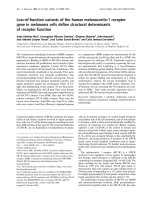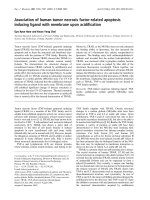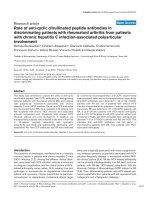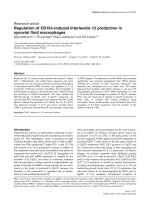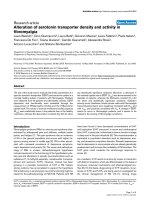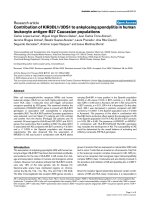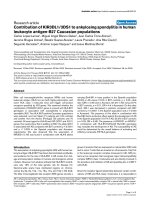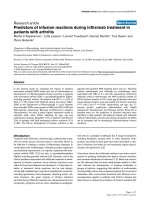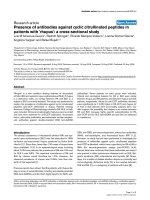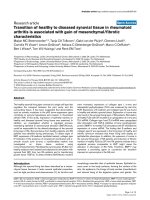Báo cáo y học: "Loss of LIN-35, the Caenorhabditis elegans ortholog of the tumor suppressor p105Rb, results in enhanced RNA interference" pps
Bạn đang xem bản rút gọn của tài liệu. Xem và tải ngay bản đầy đủ của tài liệu tại đây (417.61 KB, 10 trang )
Genome Biology 2006, 7:R4
comment reviews reports deposited research refereed research interactions information
Open Access
2006Lehneret al.Volume 7, Issue 1, Article R4
Research
Loss of LIN-35, the Caenorhabditis elegans ortholog of the tumor
suppressor p105Rb, results in enhanced RNA interference
Ben Lehner
*
, Andrea Calixto
†
, Catriona Crombie
*
, Julia Tischler
*
,
Angelo Fortunato
*
, Martin Chalfie
†
and Andrew G Fraser
*
Addresses:
*
The Wellcome Trust Sanger Institute, Hinxton, Cambridge CB10 1SA, UK.
†
Department of Biological Sciences, Columbia
University, New York, NY 10027, USA.
Correspondence: Andrew G Fraser. Email:
© 2006 Lehner et al.; licensee BioMed Central Ltd.
This is an open access article distributed under the terms of the Creative Commons Attribution License ( which
permits unrestricted use, distribution, and reproduction in any medium, provided the original work is properly cited.
RNAi sensitivity of lin-35 mutants<p>Mutations in lin-35, the worm ortholog of a mammalian tumor suppressor gene, and other synMuv B genes result in an increased sen-sitivity to RNAi and enhanced somatic transgene silencing.</p>
Abstract
Background: Genome-wide RNA interference (RNAi) screening is a very powerful tool for
analyzing gene function in vivo in Caenorhabditis elegans. The effectiveness of RNAi varies from gene
to gene, however, and neuronally expressed genes are largely refractive to RNAi in wild-type
worms.
Results: We found that C. elegans strains carrying mutations in lin-35, the worm ortholog of the
tumor suppressor gene p105Rb, or a subset of the genetically related synMuv B family of chromatin-
modifying genes, show increased strength and penetrance for many germline, embryonic, and post-
embryonic RNAi phenotypes, including neuronal RNAi phenotypes. Mutations in these same genes
also enhance somatic transgene silencing via an RNAi-dependent mechanism. Two genes, mes-4 and
zfp-1, are required both for the vulval lineage defects resulting from mutations in synMuv B genes
and for RNAi, suggesting a common mechanism for the function of synMuv B genes in vulval
development and in regulating RNAi. Enhanced RNAi in the germline of lin-35 worms suggests that
misexpression of germline genes in somatic cells cannot alone account for the enhanced RNAi
observed in this strain.
Conclusion: A worm strain with a null mutation in lin-35 is more sensitive to RNAi than any other
previously described single mutant strain, and so will prove very useful for future genome-wide
RNAi screens, particularly for identifying genes with neuronal functions. As lin-35 is the worm
ortholog of the mammalian tumor suppressor gene p105Rb, misregulation of RNAi may be
important during human oncogenesis.
Background
Introduction of double-stranded RNA (dsRNA) into meta-
zoan cells results in the sequence specific degradation of mes-
senger RNA in a process known as RNA interference (RNAi)
[1]. Components of the RNAi machinery are also involved in
the regulation of endogenous gene expression, for example, in
the silencing of repetitive DNA sequences and in the process-
ing of microRNAs [2]. RNAi has proved a very powerful tool
to examine gene function [3]. In Caenorhabditis elegans,
RNAi is now routinely used to systematically examine in vivo
Published: 20 January 2006
Genome Biology 2006, 7:R4 (doi:10.1186/gb-2006-7-1-r4)
Received: 7 September 2005
Revised: 27 October 2005
Accepted: 16 December 2005
The electronic version of this article is the complete one and can be
found online at />R4.2 Genome Biology 2006, Volume 7, Issue 1, Article R4 Lehner et al. />Genome Biology 2006, 7:R4
loss of function phenotypes on a genome-wide scale. The effi-
ciency of RNAi in C. elegans varies from gene to gene, how-
ever, such that the observed RNAi phenotype often does not
represent the true null phenotype of a gene. In particular,
genes expressed in neurons appear largely refractory to RNAi,
which has precluded the use of RNAi screens to identify genes
with neuronal functions [4]. For this reason there has been
great interest in identifying worm strains that display an
enhanced sensitivity to RNAi. Previously, mutations in two
genes have been shown to enhance RNAi sensitivity in C. ele-
gans. These genes are predicted to function in dsRNA synthe-
sis or turnover, and encode a putative RNA-dependent RNA
polymerase (rrf-3 [5]) and a ribonuclease (eri-1 [6]). A
genome-wide RNAi screen in an rrf-3 mutant strain identi-
fied 393 additional genes with RNAi phenotypes because of
its increased sensitivity to RNAi [7]. Here we report that inac-
tivation of a subset of genes that function in the LIN-35/
p105Rb chromatin-remodelling pathway also result in RNAi
hypersensitivity in C. elegans. Indeed, we found that a strain-
carrying a null allele in lin-35 is more sensitive to RNAi than
either rrf-3 or eri-1 mutant animals, making this strain an
invaluable resource for future genome-wide RNAi screens.
Results and discussion
Loss of LIN-35 results in enhanced RNAi
The loss of function phenotypes generated by RNAi, like those
generated by classic genetics, are highly dependent on the
genetic background - many genes have very different RNAi
phenotypes in a wild-type worms from those seen in animals
mutant for a specific gene. Such genetic interactions can pro-
vide insight into how genes are organised into pathways. To
begin to map out genetic interactions in the signal transduc-
tion and transcriptional networks that underpin C. elegans
development, we used RNAi to individually target approxi-
mately 1,700 genes and compare the phenotypes generated in
wild-type animals with the phenotypes in each of about 40
mutant strains; each strain carries a mutation in a key signal-
ling component or chromatin regulator (B.L, C.C, J.T, A.F and
A.G.F, manuscript submitted). The approximately 1,700
genes targeted encode the great majority of genes involved in
signal transduction and transcriptional regulation, as anno-
tated in Kamath et al. [4] (Additional data file 1). During this
screening, we noticed that the RNAi phenotypes of many
genes that had weak phenotypes in wild-type animals were
greatly enhanced in the strain lin-35(n745); this carries a
putative null mutation in the p105Rb ortholog, lin-35 [8]. In
this strain, the sterility and/or embryonic lethality of approx-
imately 30% of all genes that had a weak phenotype in wild-
type worms were enhanced (78 genes; Additional data file 2).
Furthermore, 35 genes that had no detectable phenotype in
wild-type worms had strong phenotypes in lin-35 mutants
(Additional data file 2). In particular, many RNAi clones that
result in partial F1 embryonic lethality in wild-type worms
have complete P0 sterility or growth arrest in lin-35(n745)
worms, suggesting a more rapid and complete inhibition of
gene expression in the absence of lin-35 function.
The difference in RNAi phenotype for any gene that we
observe in lin-35(n745) compared with wild-type could for-
mally result either from an increase in RNAi sensitivity in the
mutant or through some more complex genetic interactions
(for example, through genetic buffering between lin-35 and a
target gene). We believe the principal effect is through an
increase in RNAi sensitivity for four reasons.
First, for genes that have a nonviable RNAi phenotype in lin-
35(n745), the genetic null allele is also always nonviable,
when known (35 genes) (Additional data file 3), suggesting
that the stronger phenotype represents a near-null state.
Second, for genes whose genetic nulls are viable but have dis-
tinct postembryonic phenotypes (for example, uncoordi-
nated, dumpy), we also detect enhanced similar
postembryonic phenotypes by RNAi (Table 1); this group of
Table 1
Enhanced post-embryonic RNAi phenotypes observed in
lin-35(n745) worms
RNAi N2 phenotype* lin-35(n745) phenotype
dpy-13 Dpy + Dpy +++
unc-104 Unc + Unc +++
unc-18 WT Unc
*RNAi feeding experiments were performed at 20°C, as described in
[4]. Dpy, dumpy; Unc, uncoordinated; WT, wild-type. +, weak
phenotype; ++, medium phenotype; +++, strong phenotype.
Inactivation of lin-35 or lin-15B enhances RNAiFigure 1 (see following page)
Inactivation of lin-35 or lin-15B enhances RNAi. (a) The number of genes with enhanced RNAi phenotypes in the worm strains lin-35(n745), lin-15B(n744),
eri-1(mg366) and rrf-3(pk1426). The chart shows the number of genes with RNAi phenotypes that are significantly stronger in each strain than in wild-type
(Bristol N2) worms. A total of 1,838 bacterial RNAi feeding strains from the Ahringer library [4] targeting 1,749 genes were tested with each worm strain.
(b-f) RNAi-induced silencing of lin-35 or lin-15B enhances the dsRNA-induced silencing of a GFP transgene. Worm strain GR1401 expresses an integrated
GFP transgene and a dsRNA that targets GFP mRNA for degradation, both expressed specifically in the hypodermal seam cells of the worm (arrows) [9].
(b) Control experiments used a feeding strain that does not target any C. elegans gene and causes no change in the silencing of GFP. dsRNA targeting
components of the RNAi machinery such as (c) rde-4 suppress the silencing of GFP, whereas dsRNAs targeting (d) eri-1, (e) lin-35 or (f) lin-15B result in
enhanced silencing of GFP. See Table 2 for quantification of this data.
Genome Biology 2006, Volume 7, Issue 1, Article R4 Lehner et al. R4.3
comment reviews reports refereed researchdeposited research interactions information
Genome Biology 2006, 7:R4
Figure 1 (see legend on previous page)
0
20
40
60
80
100
120
lin-35 lin-15B eri-1 rrf-3
(n745)(n744)(mg366)(pk1426)
Genes with enhanced RNAi phenotypes
control
lin-35(RNAi) lin-15B(RNAi)
(a)
(b)
(e) (f)
eri-1(RNAi)rde-4(RNAi)
(c) (d)
R4.4 Genome Biology 2006, Volume 7, Issue 1, Article R4 Lehner et al. />Genome Biology 2006, 7:R4
genes includes genes that affect the neuronal system, which is
largely refractory to RNAi in wild-type animals [4].
Thirdly, we tested whether inactivation of lin-35 increases
gene silencing resulting from expression of an endogenously
transcribed dsRNA. To do this, we took advantage of a system
in which worms express GFP exclusively in the hypodermal
seam cells, along with a dsRNA targeting the green fluores-
cent protein (GFP) mRNA [9]. In wild-type animals, where
RNAi works with normal efficiency, there is a low level of GFP
fluorescence in the seam cells due to targeting by the co-
expressed dsRNA (54% of worms have GFP expression visible
in their midbody seam cells; Figure 1b, Table 2). If RNAi is
used to target genes required for RNAi, however, this reduces
GFP knock-down, and there is an observed increase in GFP
levels (for example, for rde-4, 67% of worms have GFP
expression visible in their midbody seam cells; Figure 1c,
Table 2); conversely, targeting genes whose loss increases
RNAi efficiency results in a further reduction of GFP expres-
sion (for example, for eri-1, 13% of worms have GFP expres-
sion visible in their midbody seam cells; Figure 1d, Table 2; p
< 0.001, Chi squared test). We found that targeting lin-35
causes a strong enhancement of GFP silencing in the seam
cells (1% of worms have GFP expression visible in their mid-
body seam cells; Figure 1e, Table 2; p < 0.001). When com-
bined with the enhanced RNAi phenotypes described above,
this result is consistent with a model in which inactivation of
lin-35 enhances the efficiency of RNAi. In addition, since in
this system the dsRNA is expressed in the same cells in which
the targeting occurs, we conclude that inactivation of lin-35
must enhance the cellular process of RNAi-induced gene
silencing, rather than just altering the uptake or systemic
transport of dsRNA. Taken together, these results indicate
that mutations in lin-35 cause an increase in the effectiveness
of RNAi and that this results in stronger and more penetrant
RNAi phenotypes for many genes, making lin-35(n745) an
invaluable research tool. We note that similar findings were
reported by the Ruvkun lab while this manuscript was in
preparation [10].
Finally, although inactivation of LIN-35 results in RNAi
hypersensitivity, it is possible that some of the genes with an
enhanced phenotype in lin-35(n745) animals could represent
genetic interactions between lin-35 and a target gene via a
mechanism that is independent of the RNAi hypersensitivity
of this strain. To directly identify these genes, we took advan-
tage of a strain carrying a mutation in a lin-35 pathway gene
that does not show an increased sensitivity to RNAi. In both
mammals and worms, LIN-35/Rb proteins are proposed to
function by directly binding E2F family proteins [11,12]. The
strain efl-1(se1) [13] carries a weakloss-of-function mutation
in the worm E2F family gene efl-1, which is known to function
with lin-35 in regulating cell-cycle progression [14], as well as
development of the vulva [12] and pharynx [15]. efl-1(se1) ani-
mals do not show an increased sensitivity to RNAi, as judged
by testing genes with an enhanced RNAi phenotype in rrf-
3(pk1426) animals, or by inhibiting expression of efl-1 in the
RNAi reporter strain GR1401. Thus, to identify genes that
interact genetically with the lin-35 pathway, we tested
whether genes that have an enhanced RNAi phenotype in lin-
35(n745) animals, but not in rrf-3(pk1426) animals, also had
enhanced RNAi phenotypes in efl-1(se1) animals (Additional
data file 2). We found three genes that fulfilled these criteria
(Table 3). The first of these genes is pha-1, which has
previously been identified as genetically interacting with lin-
35 and efl-1 [15], so validating the success of our approach.
The other two genes represent novel lin-35 pathway genetic
interaction partners: dpy-22 is predicted to encode a compo-
nent of the mediator complex that, like LIN-35 and EFL-1,
probably also functions in chromatin remodelling [16], and
Y106G6E.6 encodes a Casein Kinase I family member.
Intriguingly, targeting Y106G6E.6 by RNAi results in abnor-
malities in early embryonic polarity (C Panbianco and J
Ahringer, personal communication); strong reduction of efl-1
function has previously been shown to affect embryonic
polarity [13]. EFL-1 affects embryonic polarity at least in part
through regulation of MAP kinase activity in the oocyte [13]
and our data thus suggest that LIN-35, EFL-1, and
Y106G6E.6 cooperate in some way to regulate MAPK activity
in the C. elegans oocyte. There is no previously published
Table 2
RNAi induced silencing of lin-35 or lin-15B enhances the dsRNA-induced silencing of a GFP transgene
RNAi* Complete
†
GFP expression partial
‡
None
§
% Complete expression
control 44 15 23 54%
lin-35 125751%
lin-15B 116781%
eri-1 7163013%
rde-4 28 6 8 67%
*RNAi experiments were performed as described in Materials and methods.
†
Number of worms with GFP expression in all hypodermal seam cells.
‡
Number of worms with GFP expression only in their anterior and/or posterior seam cells, but not in the midbody seam cells.
§
Number of worms
with no GFP expression visible in any cells.
Genome Biology 2006, Volume 7, Issue 1, Article R4 Lehner et al. R4.5
comment reviews reports refereed researchdeposited research interactions information
Genome Biology 2006, 7:R4
functional association between p105Rb, E2F and a CKI family
member and this underlies the strength of genetic interaction
mapping as a way to reveal gene function.
lin-35 animals are more sensitive to RNAi than
previously described RNAi hypersensitive strains
We compared the RNAi sensitivity of animals carrying strong
loss-of-function mutations in the two previously described
genes that are known to negatively regulate RNAi in C.
elegans, rrf-3 or eri-1, to that of lin-35(n745) animals. rrf-
3(pk1426)[5] and eri-1(mg366)[6] enhanced the RNAi
phenotypes of 70 and 69 of 1,749 genes tested, respectively,
compared to 113 genes enhanced by lin-35(n745) (Figure 1a;
Additional data file 2). Every gene displaying an increased
phenotype with rrf-3(pk1426) or eri-1(mg366) also has an
increased RNAi phenotype with lin-35(n745). In addition,
many genes that have enhanced RNAi phenotypes in rrf-
3(pk1426) or eri-1(mg366) have even stronger phenotypes in
lin-35(n745).
Although the RNAi clones that we tested in each of the four
strains represented a functionally biased set of genes, we also
found very similar results when using random RNAi clones
targeting genes with many diverse functions. In addition to
the approximately 1,800 RNAi clones originally screened, we
also screened the first 682 RNAi clones targeting genes on C.
elegans chromosome III. These genes have very diverse
molecular functions (Additional data file 4) and we found that
42 of these clones also had RNAi phenotypes that were
stronger in lin-35(n745) than in rrf-3(pk1426) worms (Addi-
tional data file 5). In addition, it is not just the number of
genes with enhanced RNAi phenotypes that is greater in lin-
35 than in the other strains; the strengths of the RNAi pheno-
types are also enhanced. For example, 11 of the genes we
tested from chromosome III had an RNAi phenotype in rrf-3
worms that was further enhanced in lin-35 worms (Addi-
tional data file 5).
These results show that lin-35(n745) worms are more sensi-
tive to RNAi than any previously described single mutant
strain and are an ideal strain for new RNAi-based screens.
This is a key finding - merely finding another hypersensitive
strain is not a particularly useful research tool unless it is an
improvement on the previously identified strains. Our rank-
ing of the three strains is based on the use of a large set of test
genes, and thus our conclusion is robust and not a curiosity of
a few atypical RNAi phenotypes. We note, however, that
Wang et al. [10] also provide evidence that a lin-35(n745);
eri-1(mg366) double mutant strain may display a further
enhancement in RNAi sensitivity to lin-35(n745), suggesting
that these two genes may partially function in parallel.
lin-35(n745) animals display increased sensitivity to
RNAi in the nervous system
For unknown reasons, many neuronally expressed genes
appear largely refractory to RNAi in wild-type worms, pre-
cluding reverse genetic analyses [4]. We generated strong
phenotypes for several neuronally expressed genes in lin-
35(n745) animals (Table 1), suggesting RNAi-based screens
for neuronal functions might be feasible in this strain. To test
further for enhanced RNAi sensitivity in the nervous system
of lin-35(n745) animals, we focused on genes expressed in the
six touch receptor neurons of C. elegans. These neurons sense
gentle touch to the body, and several mechanosensory
abnormal (mec) genes have been identified that are needed
for their development or function [17,18]. Although RNAi has
been detected in these neurons when dsRNA is injected into
animals [19], it is not seen when dsRNA is delivered by feed-
ing in wild-type animals (AC, C Keller, and MC, unpublished
data), rendering high-throughput RNAi screens impractical.
We tested the touch sensitivity of wild-type and lin-35(n745)
animals fed on bacteria targeting eight mec genes (mec-2,
mec-3, mec-4, mec-8, mec-9, mec-10, mec-12 and mec-18)
and two unrelated genes (gfp and sym-1). In wild-type
worms, none of the bacterial strains caused touch insensitiv-
ity - that is, the Mec phenotype - either in adults that had fed
on the bacteria throughout their entire larval development or
in their progeny (n > 30 for each). Thus, if bacterial-mediated
RNAi is having an effect in the touch neurons of wild-type
animals, the effect is too small to generate a detectable phe-
notype. In contrast, in parallel experiments, lin-35 adults that
had been fed with bacteria targeting mec-2, mec-3, mec-4,
mec-9 and mec-18 throughout their larval development were
touch insensitive, although the animals displayed the Mec
phenotype with differences in penetrance and expressivity.
Penetrance ranged from 47% (mec-9) to 83% (mec-2). Bacte-
ria expressing mec-2, mec-3, and mec-4 dsRNA consistently
gave a highly penetrant phenotype with strong expressivity
(that is, the animals had a touch insensitivity similar to ani-
mals with null alleles). Bacteria making dsRNA for mec-12
produced a highly penetrant phenotype (63%) with interme-
diate strength (the animals responded to a few touches). mec-
18 bacteria produced less consistent but easily detectable
results; in some experiments the penetrance was high (60%)
and expressivity strong, whereas in others the penetrance was
lower (45%) and the expressivity intermediate. Bacteria pro-
ducing mec-9 dsRNA gave the weakest positive results with
penetrance of 47% and intermediate expressivity. These
Table 3
Identification of genes that genetically interact with the lin-35
pathway
RNAi Enhanced RNAi phenotype
efl-1(se1) lin-35(n745) rrf-3(pk1426)
pha-1 Yes Yes No
dpy-22 Yes Yes No
Y106G6E.6 Yes Yes No
R4.6 Genome Biology 2006, Volume 7, Issue 1, Article R4 Lehner et al. />Genome Biology 2006, 7:R4
weaker effects seen with mec-9, mec-12 and mec-18 may be a
consequence of the high expression of these genes in the
touch neurons [20], which might overwhelm the RNAi
machinery. Animals fed on bacteria targeting mec-8 or mec-
10 were indistinguishable from those fed on bacteria for the
gfp and sym-1 controls. Although negative RNAi results are
difficult to interpret, genetic experiments [18] indicate that
the amount of mec-8 activity produced in the embryo is suffi-
cient for subsequent adult touch sensitivity, and elimination
of mec-10 has only a slight effect on touch sensitivity (R
O'Hagan, M Goodman, and MC, unpublished data).
These data indicate that neuronally expressed genes are effec-
tively targeted by bacterial-mediated RNAi in the lin-
35(n745) strain, thus providing a very useful tool to study
gene function in these cells. These results also point to the
expression and function of lin-35 in post-mitotic neurons.
A subset of synMuv B genes negatively regulate RNAi
and somatic transgene silencing
In addition to demonstrating the usefulness of the lin-
35(n745) strain for generating enhanced RNAi phenotypes,
we wished to explore the connection between lin-35 and
RNAi. lin-35 encodes the C. elegans ortholog of the human
tumour suppressor gene p105Rb and is, therefore, presumed
to act as a chromatin regulator. Thus, while rrf-3 and eri-1
encode proteins that are intimately connected with dsRNA
synthesis and turnover, no clear mechanistic link is known
between lin-35 and RNAi, making the connection between
chromatin remodelling and RNAi an intriguing question. lin-
35 functions in the synthetic Multivulva (synMuv) B pathway
that is redundantly required with the synMuv A pathway to
antagonise the outcome of Ras signalling in the specification
of vulval cell lineages [8]. Although some synMuv genes are of
unknown molecular function, several synMuv B genes encode
the worm orthologs of components of p105Rb transcriptional
repressor complexes identified in mammals and flies [11,21-
23]. If the chromatin remodelling function of LIN-35 is
important for its effect on RNAi, one would anticipate that
strains carrying mutations in othersynMuv B genes would
also be hypersensitive to RNAi. To test the RNAi sensitivity of
synMuv strains, we used the subset of bacterial feeding clones
that gave an enhanced RNAi phenotype in rrf-3(pk1426) ani-
mals. We tested these clones for enhanced RNAi phenotypes
in each of the synMuv strains compared to in wild-type
worms. We found that strains carrying inactivating mutations
in the synMuv B genes lin-15B (Figure 1a, Table 4), dpl-1, and
lin-9 (Table 4) also enhanced the RNAi phenotypes of the
majority of these genes. In addition, Sieburth et al. [24] have
shown that an eri-1; lin-15B double mutant is also hypersen-
sitive to neuronal RNAi phenotypes. In contrast, strong loss-
of-function mutations in two other synMuv B genes, lin-36
and tam-1, or the synMuv A gene lin-15A did not enhance any
RNAi phenotypes for these genes (Table 4). We conclude that
a subset of synMuv B genes negatively regulate RNAi, which
we refer to as synMuv B(R) genes. Wang et al.[10] obtained
similar results.
In addition to increasing sensitivity to RNAi, inactivation of
the genes rrf-3 or eri-1 also results in the silencing of somati-
cally expressed transgene tandem arrays via an RNAi-
dependent mechanism [9]. Consistent with their having roles
as negative regulators of the RNAi pathway, inactivation of
synMuv B(R) genes also results in somatic transgene
silencing [25] (data summarised in Tables 4 and 5 and Figure
2b,c). In contrast, inactivation of other synMuv B or synMuv
A genes does not result in somatic transgene silencing [25]
(Table 4). Somatic transgene silencing in animals with
inactivated synMuv B(R) genes can be suppressed by inacti-
vation of components of the RNAi machinery (Figure 2e,f,h,i,
Table 5). Thus we conclude that inactivation of synMuv B(R)
genes induces somatic transgene silencing as a result of an
increase in RNAi. We also note, however, that mutations in at
least one other synMuv B gene, tam-1, can enhance somatic
Table 4
A subset of synMuv B genes negatively regulate RNAi, somatic transgene silencing and expression of lag-2::gfp
Gene synMuv Enhanced RNAi* Somatic transgene
silencing
†
Ectopic expression of lag-
2::gfp
‡
lin-35(n745) BYesYesYes
lin-15B(n744) BYesYesYes
lin-9(n112) BYesYesYes
dpl-1(n3643) BYesndNd
lin-36(n766) B NoNoNo
tam-1(cc567) BNoYesnd
lin-15A(n767) A NoNoNo
lin-15A;B(n765) AB Yes nd nd
*RNAi sensitivity was determined as described above, but using the subset of bacterial feeding clones that gave an enhanced RNAi phenotype in rrf-
3(pk1426).
†
Somatic transgene silencing data are taken from [25].
‡
lag-2::gfp expression data are taken from [26]. nd, not determined.
Genome Biology 2006, Volume 7, Issue 1, Article R4 Lehner et al. R4.7
comment reviews reports refereed researchdeposited research interactions information
Genome Biology 2006, 7:R4
transgene silencing [25], but without any observable effect on
RNAi sensitivity (Table 4). This suggests that other genes may
be able to enhance transgene silencing independently of the
RNAi pathway via an unknown mechanism. Indeed, we found
that RNAi of dcr-1 does not suppress transgene silencing in a
strain carrying a mutation in tam-1 (reduced transgene
silencing was seen in 0 of >300 tam-1(cc567) [25] animals
tested (Additional data file 6)). The general picture is clear,
however: the subset of synMuv B genes that affects RNAi sen-
sitivity is very similar to the subset that alters transgene
silencing, suggesting that these form a genetically distinct
group of synMuv B genes.
Additional evidence suggests this subclassification of synMuv
B genes is functionally relevant. Inactivation of a subset of
synMuv B genes results in ectopic expression of a lag-2::gfp
reporter gene [26]. Strikingly, all of the synMuv B genes that
we found to be negative regulators of the RNAi pathway and
negative regulators of somatic transgene silencing also nega-
tively regulate lag-2::gfp expression [26] (Table 4). This
result suggests a similar synMuv B(R) pathway may regulate
both the RNAi pathway and correct expression of this trans-
gene, and supports the classification of synMuv B genes into
at least two distinct functional subsets.
Genes required for RNAi can suppress the lineage
defects of synMuvA;B strains
Combined mutations in both a synMuv A and a synMuv B
gene (for example, in the lin-15A;B (n765) strain) results in
the development of ectopic vulvae (the so-called multivulva
lin-35 and lin-15B enhance somatic transgene silencing by an RNAi dependent mechanismFigure 2
lin-35 and lin-15B enhance somatic transgene silencing by an RNAi dependent mechanism. Worm strain JR667 expresses GFP specifically in the hypodermal
seam cells from an integrated tandemly repeated array of the construct wIs51, which contains the scm::GFP reporter (a). Inactivation of either lin-35 (b) or
lin-15B (c) results in enhanced silencing of the GFP transgene via a mechanism that is dependent upon the RNAi machinery, including dcr-1 (e-f) and rde-4
(h-i). Inactivation of dcr-1 (d) or rde-4 (g) alone results in a slight increase in GFP expression, indicating a background level of transgene silencing in wild-
type worms. Worms were fed on 1:1 mixes of the indicated RNAi feeding strains and RNAi feeding experiments were performed as described in Materials
and methods. Control (ctrl) RNAi experiments used the same non-targeting RNAi clone as used in Figure 1. See Table 5 for quantification of this data.
scm::GFP;
lin-35(RNAi); ctrl(RNAi)
scm::GFP;
lin-15B(RNAi); ctrl(RNAi)
scm::GFP;
ctrl(RNAi)
scm::GFP;
lin-35(RNAi); dcr-1(RNAi)
scm::GFP;
lin-15B(RNAi); dcr-1(RNAi)
scm::GFP;
lin-35(RNAi); rde-4(RNAi)
scm::GFP;
lin-15B(RNAi); rde-4(RNAi
)
scm::GFP;
dcr-1(RNAi); ctrl(RNAi)
scm::GFP;
rde-4(RNAi); ctrl(RNAi)
(a) (b) (c)
(d) (e) (f)
(g) (h) (i)
R4.8 Genome Biology 2006, Volume 7, Issue 1, Article R4 Lehner et al. />Genome Biology 2006, 7:R4
or Muv phenotype). In an RNAi screen for genes that can sup-
press the Muv phenotype of a lin-15A;B(n765) strain, we
identified two genes, mes-4 and zfp-1, that have been previ-
ously identified as necessary for both RNAi and somatic
transgene silencing (Table 6; C.C and A.G.F, unpublished
data) [9,27]. These genes both have clear human orthologs,
and are both predicted to encode components of chromatin
modifying complexes: mes-4 encodes a putative trithorax-
group histone methyltransferase protein with a SET domain
and three PHD finger domains and is orthologous to human
WHSC1L1, and zfp-1 encodes a PHD finger domain protein
and is orthologous to human MLLT10/AF10, a fusion partner
of MLL (a mes-4 related gene) in acute leukaemia [28]. The
requirement of mes-4 and zfp-1 for RNAi and their ability to
suppress mutations in synMuvA;B mutants, suggests that a
common mechanism may underlie the role of synMuv B
genes in these two processes (Figure 3).
An increase in RNAi efficiency does not cause the
lineage defects of synMuv B mutants
The precise molecular functions of the synMuv B(R) genes
and of mes-4 and zfp-1 in vulva development and in RNAi are
unknown; however many of these genes are predicted by
sequence homology to regulate chromatin structure. One
intriguing possibility is that a key function of the synMuv
B(R) genes during vulva development may be to repress
RNAi. The Muv phenotype might thus be due in part to alter-
ations in RNAi-related processes. We investigated this in two
complementary ways. Firstly, if the sole effect of synMuv B(R)
genes on vulval development was through their effect on
RNAi sensitivity, then other genes that similarly increase
RNAi sensitivity should act as synMuv B genes. However,
while targeting lin-35 by RNAi produces a strong Muv pheno-
type in a lin-15A mutant animal (as expected given its synMuv
B activity), targeting eri-1 has no similar effect. Secondly,
inactivation of the synMuv B(R) genes enhances RNAi and in
the absence of synMuv A activity leads to multivulval devel-
opment; to determine if these two functions were causally
related, we asked whether inactivation of other genes that are
essential for RNAi (rde-1, rde-4, rde-5, mut-7 or mut-16) sup-
presses the Muv phenotype of lin-15A;B(n765) - they do not.
Hence, we find that genes that enhance RNAi do not all act as
synMuv B genes and, conversely, that the RNAi machinery is
not necessary for the synMuv phenotype. Thus, alterations in
the efficacy of RNAi cannot alone account for the action of lin-
35 in vulval development, although it may contribute to lin-
35's role.
Wang et al. [10] suggest that the enhanced RNAi seen in syn-
Muv B mutants may result from the misexpression of germ-
line genes in somatic cells. Although this may contribute to
the enhanced somatic RNAi seen in synMuv B strains, we
found that lin-35(n745) animals also showed enhanced germ-
line RNAi phenotypes (>50 genes gave strong sterility in lin-
35(n745) but not in wild-type worms) (Additional data file 2).
Although some of these sterile phenotypes may result from
defects in somatic cells, a subset of these genes has been pre-
viously shown to function within the germline itself. In C. ele-
gans, the Notch and MAP kinase pathways are both required
within the germline for correct germline development
[29,30], and we found that four genes that function in these
pathways also show strongly enhanced RNAi-induced steril-
ity in lin-35(n745) worms (the genes glp-1, lag-1, let-60 and
Table 5
lin-35 and lin-15B enhance somatic transgene silencing by an
RNAi dependent mechanism
RNAi* GFP expression % Complete
expression
Complete
†
Partial
‡
control 27 2 93%
dcr-1; control 15 0 100%
rde-4; control 19 0 100%
lin-35; control 1118%
lin-35; dcr-1 11 18 38%
lin-35; rde-4 14 17 45%
lin-15B; control 2 14 13%
lin-15B; dcr-1 30 2 94%
lin-15B; rde-4 25 5 83%
*RNAi experiments were performed as described in Materials and
methods.
†
Number of worms with GFP expression in all hypodermal
seam cells.
‡
Number of worms with GFP expression only in their
anterior and/or posterior seam cells, but not in the midbody seam cells.
A comparison of the genetic pathways that regulate RNAi and vulval developmentFigure 3
A comparison of the genetic pathways that regulate RNAi and vulval
development. A subset of the synthetic Multivulva B genes, designated the
synMuv B(R) genes, negatively regulate vulval induction (redundantly with
the synMuv A pathway), and also negatively regulate somatic and germline
RNAi. In both processes the genes mes-4 and zfp-1 act genetically
downstream of, or in parallel to, the synMuv B(R) genes. The identities of
the synMuv B(R) genes are given below the figure.
synMuv B(R)
RNAi
RNAi
machinery
synMuv B
vulval
induction
synMuv
A
? ?
synMuv B (R): lin-35, lin-15B, dpl-1, lin-9
MES-4
ZFP-1
MES-4
ZFP-1
Genome Biology 2006, Volume 7, Issue 1, Article R4 Lehner et al. R4.9
comment reviews reports refereed researchdeposited research interactions information
Genome Biology 2006, 7:R4
lin-45; Additional data file 3). Since the enhanced sterility
seen with these genes must result from enhanced gene silenc-
ing within the germline itself, these data demonstrate that
RNAi is also enhanced in the germline of lin-35(n745) worms,
and that somatic misexpression of germline genes does not
alone account for the enhanced RNAi seen in synMuv B
mutants. We favour a model in which the synMuv B(R) genes
and mes-4/zfp-1 act antagonistically to regulate the
expression of a common set of target genes. These targets
could include genes that are required for vulval development
and genes required for RNAi, or the genes targeted by RNAi
themselves. The antagonism may involve the direct repres-
sion of mes-4 and zfp-1 by the synMuv B(R) genes, or the
antagonistic action of mes-4/zfp-1 and the synMuv B(R)
genes on a common set of target genes (Figure 3). Alterna-
tively, MES-4/ZFP-1 and the synMuv B(R) gene products
may antagonise each other's functions by competing for a
common set of co-factors.
Conclusion
We have found that lin-35 and a subset of synMuv B pathway
genes negatively regulate RNAi in C. elegans, probably via a
mechanism involving chromatin remodelling. The efficiency
of RNAi is enhanced within both somatic and germline cells
of lin-35 animals, demonstrating that misexpression of germ-
line genes in somatic cells cannot alone account for the
enhanced RNAi seen in this strain. lin-35(n745) is the most
RNAi-sensitive single mutant strain identified to date and,
therefore, should prove very useful for genome-wide RNAi
screens. We note that the availability of five strains with var-
ying RNAi-sensitivities (lin-35(n745) > lin-15B(n744) > eri-
1(mg366) approximately = rrf-3(pk1426) > N2; Figure 1a)
opens the possibility of studying an 'allelic series' of RNAi
phenotypes for many genes (for example, when L1 wild-type
or lin-15B(n744) worms are fed on bacteria targeting the gene
ftt-2, they reach adulthood, at which point wild-type worms
have a reduced brood size while the lin-15B(n744) worms are
completely sterile; the RNAi phenotype is so severe in lin-
35(n745) worms, however, that the L1 worms never reach
adulthood, and instead show a completely penetrant larval
growth arrest). We have also identified two genes (mes-4 and
zfp-1) that are both required for RNAi and can suppress the
vulval lineage defects resulting from inactivation of synMuv
genes, suggesting a common mechanism for the action of syn-
Muv B(R) genes in both of these processes. However, the
increased efficiency of RNAi in synMuv B mutants does not
alone explain the lineage defects of synMuv B strains.
Finally, it is possible that the human ortholog of LIN-35,
p105Rb, may also negatively regulate RNAi, and its effect on
the RNAi pathway may be important for its function as a
tumour suppressor. In addition, inactivation of the human
orthologs of mes-4 or zfp-1 may reverse some of the pheno-
typic consequences of mutations in p105Rb.
Materials and methods
RNAi screens by bacterial feeding
All of the RNAi feeding experiments described in this manu-
script were performed in liquid culture by adding synchro-
nised L1 stage worms, unless otherwise indicated. A total of
1,868 bacterial RNAi feeding strains from the Ahringer
library [4] targeting 1,749 genes were tested with each worm
strain. The vast majority of these genes are those annotated as
'signalling', 'chromatin', or 'transcription factors' in reference
[4] (Additional data file 1); feeding approximately 75% of
these bacterial strains gave no visible RNAi phenotypes in
wild-type worms [4]. Bacterial RNAi feeding strains were
grown overnight at 37°C in 400 µl 2TY plus 100 µg/ml ampi-
cillin, induced with 4 mM IPTG (isopropyl-beta-D-thiogalact-
opyranoside) at 37°C for 1 hour, and resuspended in 400 µl
NGM(Nematode Growth Medium) plus 4 mM IPTG plus 100
µg/mlampicillin. Approximately 10 L1 stage worms were dis-
pensed to each well of a 96-well flat bottomed tissue culture
plate together with 40 µl of resuspended bacterial culture.
The plates were incubated with shaking at 20°C for four days,
and embryonic lethal, sterile, growth defect and post-embry-
onic phenotypes were scored on a dissecting microscope. All
RNAi feeding experiments were performed in quadruplicate
and the phenotypes observed in each strain were directly
compared to those seen in N2 worms grown in parallel.
Transgene silencing assays
Worm strain JR667 expresses GFP specifically in the hypo-
dermal seam cells from an integrated tandemly repeated
array of the construct wIs51, which contains the scm::GFP
reporter. Worm strain GR1401 expresses the same integrated
GFP transgene, as well as a dsRNA that targets GFP mRNA
for degradation, also specifically in the hypodermal seam cells
of the worm [9]. RNAi experiments were performed on six-
well plates seeded with the indicated bacterial RNAi feeding
strain (grown overnight as described above). Approximately
10 L1 stage worms were added to each well and incubated at
25°C for four days, unless otherwise indicated. The progeny
worms were washed off the plates, paralysed in 100 mM levi-
masole and GFP expression was visualised using an Olympus
IX81 microscope. Control experiments used a feeding strain
that does not target any C. elegans gene (constructed using
Table 6
mes-4 and zfp-1 suppress the multivulval phenotype of lin-
15A;B(n765) worms
Genotype Multivulval*
lin-15A;B(n765);control(RNAi) 100% (n = 300)
lin-15A;B(n765); mes-4(RNAi) 5% (n = 172)
lin-15A;B(n765); zfp-1(RNAi) 46% (n = 96)
*RNAi experiments were performed at 20°C, as described in [4].
R4.10 Genome Biology 2006, Volume 7, Issue 1, Article R4 Lehner et al. />Genome Biology 2006, 7:R4
primers sjjY95B8A_84.g, defined in [31]). All other RNAi
assays were performed exactly as described in [4].
Additional data files
The following additional data are available with the online
version of this paper. Additional data file 1 provides the com-
plete set of genes screened by RNAi feeding. Additional data
file 2 lists genes with an enhanced RNAi phenotype in each of
four RNAi hypersensitive strains, and in efl-1(se1). Additional
data file 3 lists genes with nonviable RNAi phenotypes in lin-
35(n745) that also have nonviable null phenotypes. Addi-
tional data file 4 lists genes from chromosome III tested for
enhanced RNAi phenotypes in the strains lin-35(n745) and
rrf-3(pk1426). Additional data file 5 lists genes from the start
of chromosome III with an enhanced RNAi phenotype in lin-
35(n745) compared to rrf-3(pk1426). Additional data file 6 is
a figure showing that loss of dcr-1 does not suppress somatic
transgene silencing resulting from inactivation of tam-1.
Additional data file 1The complete set of genes screened by RNAi feedingThe complete set of genes screened by RNAi feeding.Click here for fileAdditional data file 2Genes with an enhanced RNAi phenotype in each of four RNAi hypersensitive strains, and in efl-1(se1)Genes that have an enhanced RNAi phenotype in each of the hyper-sensitive strains or in the non-hypersensitive strain efl-1(se1) are indicated. Genes with a weak RNAi phenotype in wild-type (N2) worms are also indicated, together with the RNAi phenotype in lin-35(n745) animals. Emb, embryonic lethal; Gro, growth arrest of parental generation resulting in an F1 brood size of 0; Red, reduced brood size; Ste, sterile.Click here for fileAdditional data file 3Genes with nonviable RNAi phenotypes in lin-35(n745) that also have nonviable null phenotypesGenes with nonviable RNAi phenotypes in lin-35(n745) that also have nonviable null phenotypes.Click here for fileAdditional data file 4Genes from chromosome III tested for enhanced RNAi phenotypes in the strains lin-35(n745) and rrf-3(pk1426)Genes from chromosome III tested for enhanced RNAi phenotypes in the strains lin-35(n745) and rrf-3(pk1426). Gene 'functional class' descriptions are taken from [4].Click here for fileAdditional data file 5Genes from the start of chromosome III with an enhanced RNAi phenotype in lin-35(n745) compared to rrf-3(pk1426)682 RNAi clones targeting genes from the start of chromosome III were fed to lin-35(n745), rrf-3(pk1426) and wild-type worms. Forty-two clones had an RNAi phenotype that was stronger in lin-35(n745) than in rrf-3(pk1426). Of these, 11 had an RNAi pheno-type in rrf-3 that was further enhanced in lin-35. 0, no visible phe-notype; Adl, adult lethal; Emb, embryonic lethal (scored on a semi-quantitative scale from 0 to 3); Gro, growth arrest in first genera-tion; Lvl, larval lethal in first generation; Red, reduced brood size; Ste, sterile.Click here for fileAdditional data file 6Loss of dcr-1 does not suppress somatic transgene silencing result-ing from inactivation of tam-1Strain PD6249 expresses a myo-3::GFP transgene in all muscle cells. Expression of the transgene is partially silenced at 20°C due to a mutation in the gene tam-1 [25]. RNAi against (a) a control gene, or (b) dcr-1 has no effect on the level of transgene silencing (in contrast to silencing resulting from loss of lin-35, which is lost if components of the RNAi pathway are inactivated; Figure 2).Click here for file
Acknowledgements
We thank the C. elegans Genetics Center for providing worm strains, Gary
Ruvkun for providing worm strains and sharing prepublication data, and
Irini Topalidou for assistance with the touch neuron screen. B.L. is sup-
ported by a Sanger Institute Postdoctoral Fellowship, C.C., J.T., A.F., and
A.G.F. is supported by the Wellcome Trust, and M.C. is funded by NIH
grant GC30997.
References
1. Fire A, Xu S, Montgomery MK, Kostas SA, Driver SE, Mello CC:
Potent and specific genetic interference by double-stranded
RNA in Caenorhabditis elegans. Nature 1998, 391:806-811.
2. Mello CC, Conte D Jr: Revealing the world of RNA
interference. Nature 2004, 431:338-342.
3. Lehner B, Fraser AG, Sanderson CM: Technique review: how to
use RNA interference. Brief Funct Genomic Proteomic 2004,
3:68-83.
4. Kamath RS, Fraser AG, Dong Y, Poulin G, Durbin R, Gotta M, Kana-
pin A, Le Bot N, Moreno S, Sohrmann M, et al.: Systematic func-
tional analysis of the Caenorhabditis elegans genome using
RNAi. Nature 2003, 421:231-237.
5. Simmer F, Tijsterman M, Parrish S, Koushika SP, Nonet ML, Fire A,
Ahringer J, Plasterk RH: Loss of the putative RNA-directed
RNA polymerase RRF-3 makes C. elegans hypersensitive to
RNAi. Curr Biol 2002, 12:1317-1319.
6. Kennedy S, Wang D, Ruvkun G: A conserved siRNA-degrading
RNase negatively regulates RNA interference in C. elegans.
Nature 2004, 427:645-649.
7. Simmer F, Moorman C, van der Linden AM, Kuijk E, van den Berghe
PV, Kamath RS, Fraser AG, Ahringer J, Plasterk RH: Genome-wide
RNAi of C. elegans using the hypersensitive rrf-3 strain
reveals novel gene functions. PLoS Biol 2003, 1:E12.
8. Lu X, Horvitz HR: lin-35 and lin-53, two genes that antagonize
a C. elegans Ras pathway, encode proteins similar to Rb and
its binding protein RbAp48. Cell 1998, 95:981-991.
9. Kim JK, Gabel HW, Kamath RS, Tewari M, Pasquinelli A, Rual JF,
Kennedy S, Dybbs M, Bertin N, Kaplan JM, et al.: Functional
genomic analysis of RNA interference in C. elegans. Science
2005, 308:1164-1167.
10. Wang D, Kennedy S, Conte D Jr, Kim JK, Gabel HW, Kamath RS,
Mello CC, Ruvkun G: Somatic misexpression of germline P
granules and enhanced RNA interference in retinoblastoma
pathway mutants. Nature 2005, 436:593-597.
11. Frolov MV, Dyson NJ: Molecular mechanisms of E2F-depend-
ent activation and pRB-mediated repression. J Cell Sci 2004,
117:2173-2181.
12. Ceol CJ, Horvitz HR: dpl-1 DP and efl-1 E2F act with lin-35 Rb
to antagonize Ras signaling in C. elegans vulval development.
Mol Cell 2001, 7:461-473.
13. Page BD, Guedes S, Waring D, Priess JR: The C. elegans E2F- and
DP-related proteins are required for embryonic asymmetry
and negatively regulate Ras/MAPK signaling. Mol Cell 2001,
7:451-460.
14. Boxem M, van den Heuvel S: C. elegans class B synthetic multi-
vulva genes act in G(1) regulation. Curr Biol 2002, 12:906-911.
15. Fay DS, Qiu X, Large E, Smith CP, Mango S, Johanson BL: The coor-
dinate regulation of pharyngeal development in C. elegans by
lin-35/Rb, pha-1, and ubc-18. Dev Biol 2004, 271:11-25.
16. Moghal N, Sternberg PW: A component of the transcriptional
mediator complex inhibits RAS-dependent vulval fate
specification in C. elegans. Development 2003, 130:57-69.
17. Chalfie M, Sulston J: Developmental genetics of the mechano-
sensory neurons of Caenorhabditis elegans. Dev Biol 1981,
82:358-370.
18. Chalfie M, Au M: Genetic control of differentiation of the
Caenorhabditis elegans touch receptor neurons. Science 1989,
243:1027-1033.
19. Zhang Y, Chalfie M: MTD-1, a touch-cell-specific membrane
protein with a subtle effect on touch sensitivity. Mech Dev
2002, 119:3-7.
20. Zhang Y, Ma C, Delohery T, Nasipak B, Foat BC, Bounoutas A, Busse-
maker HJ, Kim SK, Chalfie M: Identification of genes expressed
in C. elegans touch receptor neurons. Nature 2002,
418:331-335.
21. Lipsick JS: synMuv verite - Myb comes into focus. Genes Dev
2004, 18:2837-2844.
22. Lewis PW, Beall EL, Fleischer TC, Georlette D, Link AJ, Botchan MR:
Identification of a Drosophila Myb-E2F2/RBF transcriptional
repressor complex. Genes Dev 2004, 18:2929-2940.
23. Korenjak M, Taylor-Harding B, Binne UK, Satterlee JS, Stevaux O,
Aasland R, White-Cooper H, Dyson N, Brehm A: Native E2F/RBF
complexes contain Myb-interacting proteins and repress
transcription of developmentally controlled E2F target
genes. Cell 2004, 119:181-193.
24. Sieburth D, Ch'ng Q, Dybbs M, Tavazoie M, Kennedy S, Wang D,
Dupuy D, Rual JF, Hill DE, Vidal M, et al.: Systematic analysis of
genes required for synapse structure and function. Nature
2005, 436:510-517.
25. Hsieh J, Liu J, Kostas SA, Chang C, Sternberg PW, Fire A: The RING
finger/B-box factor TAM-1 and a retinoblastoma-like protein
LIN-35 modulate context-dependent gene silencing in
Caenorhabditis elegans. Genes Dev 1999, 13:2958-2970.
26. Poulin G, Dong Y, Fraser AG, Hopper NA, Ahringer J: Chromatin
regulation and sumoylation in the inhibition of Ras-induced
vulval development in Caenorhabditis elegans. EMBO J 2005,
24:2613-23.
27. Dudley NR, Labbe JC, Goldstein B: Using RNA interference to
identify genes required for RNA interference. Proc Natl Acad
Sci USA 2002, 99:4191-4196.
28. Chaplin T, Ayton P, Bernard OA, Saha V, Della Valle V, Hillion J, Gre-
gorini A, Lillington D, Berger R, Young BD: A novel class of zinc
finger/leucine zipper genes identified from the molecular
cloning of the t(10;11) translocation in acute leukemia. Blood
1995, 85:1435-1441.
29. Church DL, Guan KL, Lambie EJ: Three genes of the MAP kinase
cascade, mek-2, mpk-1/sur-1 and let-60 ras, are required for
meiotic cell cycle progression in Caenorhabditis elegans.
Development 1995, 121:2525-2535.
30. Austin J, Kimble J: glp-1 is required in the germ line for regula-
tion of the decision between mitosis and meiosis in C.
elegans. Cell 1987, 51:589-599.
31. Wormbase []
